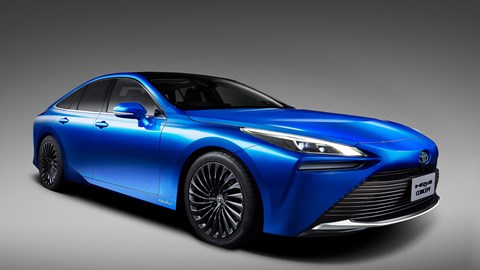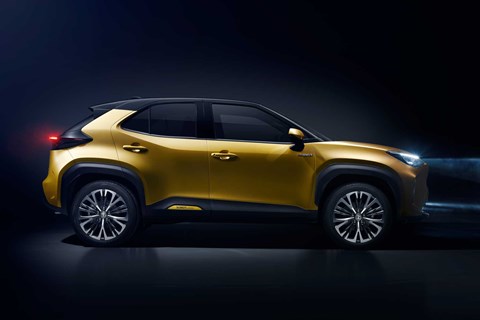► Toyota's big electric plans
► EVs finally arrive alongside hybrids
► But so does stylish hydrogen power
Toyota has shown its new bZ4X electric car - the harbinger of its new Beyond Zero programme. The Toyota EV looks like a tall-riding mid-sized crossover whose very Japanese styling references the Prius hybrid and Mirai hydrogen-powered saloons.
It's been co-developed with Subaru, who contributed its all-wheel drive expertise, and production is scheduled to start in mid 2022. Read the full story on the BZ4X concept car here.
While car brands such as Volkswagen and Hyundai/Kia have gone all in electrification, Toyota and its Lexus luxury division have taken a more varied approach: EVs are (finally) on the menu alongside plug-in and self-charging hybrids, but you'll also find the rather impressive-looking Mirai too. Keep reading for a breakdown of Toyota's multi-pronged, alternative fuels plans.
Battery electric Toyotas
Toyota has always been more cautious on battery electric vehicles (BEVs), but it can't ignore the rising tide of all-electric models from rivals. The Toyota EV you see above is proof that the company is developing its own and plans a BEV as part of a wider mix of electrified models. It believes that different use cases deserve different powerplants.
The group's first battery-electric model, the Lexus UX300e, is a version of the smallest Lexus SUV and didn't arrive until 2020. With a 54kWh battery, it was pretty conventional and boasted a range of 196 miles and a 7.5sec 0-62mph time. You can read our review of it here.
Although it’s the company’s first BEV, Toyota says its decades of hybrid know-how fed directly into the development of the UX300e’s motor, inverter, gears and battery. And it's that knowledge transfer, Toyota's broader approach to EVs, that'll mark out its strategy as distinct from its rivals, some of whom are throwing the kitchen sink into the devleopment of pure BEVs, as if they are a dead-cert solution.
Toyota prefers a broader approach to risk management, it seems...
Read more about the Lexus UX300e here
Toyota's hydrogen fuel cell
Toyota is hedging its future powertrain bets. The original Mirai was built to make a point: that hydrogen fuel cells can work on everyday road cars. Just as well it wasn’t built to sell well, because it hasn’t: the Mk1, introduced in 2014, has sauntered to 10,000 sales in all, about 1000 of them in Europe. Nobody blames Toyota – the problem is the scant provision of hydrogen refuelling stations.

The Mk2 has been designed to be good to drive as well as economical and clean-running, with water the only tailpipe emission from the combustion process. It’s also been designed to sell, if by some miracle the infrastructure gets upped soon. It looks more conventional and is lower than the Mk1 but is roomier than before, with room for five adults.
The improved fuel cell system now uses three hydrogen tanks. It sits on the GA-L rear-drive platform, as used on the Lexus LS.
Read more about the new Toyota Mirai here
Plug-in hybrid Toyotas
There have been two generations of Prius plug-in hybrid, and they’re now joined by a significantly quicker PHEV, a rapid new version of the RAV4. Combining a 2.5-litre petrol four with an electric motor fed by a bigger battery than the self-charging hybrid, the RAV4 PHEV has a 0-62mph time of 6.2 seconds and an electric-only range of about 40 miles. It can also go at up to 80mph in EV mode (but not for 40 miles).

It also gets a restyled nose, new wheels, new upholstery, and the biggest info screeen of any RAV4 at nine inches.
Launching in 2020, it’s the second most powerful car in the Toyota range, behind the Supra, and the third fastest, behind the Supra and the GR Yaris.
Read more about the new RAV4 hybrid here
Self-charging hybrid
Those old things? The bedrock of the Toyota and Lexus line-ups remains the non-plug-in hybrid – ever-evolving technology that’s now in its fourth generation.
Newcomers include a much improved hybrid version of the 2020 Yaris (drive it in EV mode at up to 80mph), with increased responsiveness and more linear power delivery claimed from the 50 per cent more powerful petrol engine. There will also be a Yaris-based SUV, with all-wheel drive and hybrid power among the spec choices; expect that to be unveiled very soon.
And the current Corolla will soon be available with a largely cosmetic GR Sport makeover, with diferent wheels and grille, piano black accents, a new steering wheel and marginally friskier upholstery. You get a choice of estate or hatch bodies, and 1.8 or 2.0-litre hybrids.
Q&A with Matt Harrison

From Brexit to the engine ban and beyond – six huge questions about the future of Toyota, answered by Matt Harrison, executive vice-president, sales, at Toyota Motor Europe
How will you cope with petrol cars being banned in 2030?
‘It’s a long way to travel in the next decade to be delivering real accessible, high-volume, full-electric, zero-emission products. But we’re confident we can adapt as necessary.
‘The strategy to 2025 has been built to meet 80g/km of CO2 emissions, the further milestone that’s required. Probably by 2025 we’ll be a 70 per cent hybrid mix, about 20 per cent plug-in, plus the zero-emission vehicles entering the line-up, and about 10 per cent ICE by then.
‘Fast forward now to 2030, it seems very clear that they want to further challenge CO2 reduction to 50 per cent below the 2010 level, and that will probably mean we have to target something like 50 per cent of our mix to be plug-in plus zero-emissions vehicles. We’ll have a more challenging second half of the decade. But we’re lucky that we’re a manufacturer that has all of these technologies. We’re able to do that.
‘But it requires much more than the OEMs. It requires great collaboration in terms of infrastructure and the supply grid. We will do our best to make the products accessible. Full electrics are certainly gaining – around 10-11 per cent of the market is electrified today, and probably one third of that is fully electric, but heavily subsidised, and that’s what’s stimulating demand.’
Doesn’t the GR Yaris make the rest of the range look a bit dull?
‘We’re very respected, we’re reliable, we’re very durable. People buy us for rational reasons. People don’t buy Toyota for emotional reasons. We need more emotion. So the fact that we’ve managed to create the Supra and the GR Yaris is fantastic.
‘With 15 per cent of our Corrola and Yaris customers buying the GR Sport grade, that transforms our image. The halo products themselves might not make great financial sense, but when you add the whole thing together it does.

‘There will be more, not less, in the short term. But towards 2030 there’s going to be limits to the ICE products that can come, and the volume role that they can play in Europe, so increasingly those may have to be more electrified solutions.’
Why would anyone buy a pure-electric Toyota crossover instead of any other electric crossover?
‘We certainly want to protect the Toyota DNA in the product. From a design point of view, from a driving character point of view, from a safety point of view, from a refinement point of view, all of these things we will protect, and we will be consistent across all of these technologies.
‘We’re in an advantageous position where we’re not forced to move quicker than we’re comfortable to move [because Toyota’s hybrid-rich line-up means it’s comfortably meeting emissions targets]. We can really be driven by what the consumer actually wants.
‘Depending which region of the world you are in, or which country, different customers will naturally choose different solutions. But over time, as the scale of BEVs improves, the costs will improve, the range will improve and hopefully, as long as the infrastructure improves and the supply grid is upgraded accordingly, then naturally we will see that growth. But clearly the amount of incentivisation today is not sustainable.
‘We’re going one step at a time. We expect rapid increase of zero-emission vehicles from 2025, but we will let the customer determine the speed and what vehicle lines need to be prioritised. We’re still in discussion about the line-up we expect from 2025 onwards.’

Are you serious about hydrogen?
‘We’re inundated with inquires and opportunities to collaborate or to join consortiums to advance deployment of hydrogen power solutions, right across all the transport sectors.
‘We have many cities talking to us directly saying how quickly can you help us mobilise this transition, under pressure on clean air and everything else.
‘We’re trying to collaborate with each of these sectors with the sole purpose of building the infrastructure, making it viable, and then the passenger car and light commercial vehicle volumes will be able to develop more quickly. It’s much more of a hydrogen society approach as opposed to a passenger car model launch plan.
‘We believe green hydrogen, with its storage capabilities, will, long term, be the optimal solution. But realistically you’re talking beyond 2030 before you see significant volumes.’
Why does Toyota keep calling itself a mobility provider, when mostly it just makes cars?
‘When you look at the challenges cities are facing in terms of pollution and congestion, we need to find better ways of integrating public transport with personal mobility solutions. We don’t see that as a complete change in business, just an expansion.
‘Covid has certainly dented the desire in the short term to share cars, but we learnt enough beforehand to know that the younger generation are not obsessed by ownership. Shorter term subscribptions, or having access to shared mobility solutions, is something that works very well for them, and I really expect that to come back.
‘Our vision is realistic. Where there’s sufficient demand for those services, we will deploy them. The future expansion of demand in these areas is a given. We’ll be ready to meet it.’
Are you worried about Brexit?
‘There seems to be great determination on both sides to find a solution. We’ve been very clear that we need a deal. As a major manufacturer in the UK, selling 90 per cent of our production into the EU, we need a relationship that’s tarrif-free and as hassle-free as possible. We’re focused on letting them do their job, and we’ll deal with the consequences. We’ll adapt, and focus on making ourselves competitive.’
Browse all our Toyota reviews